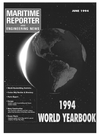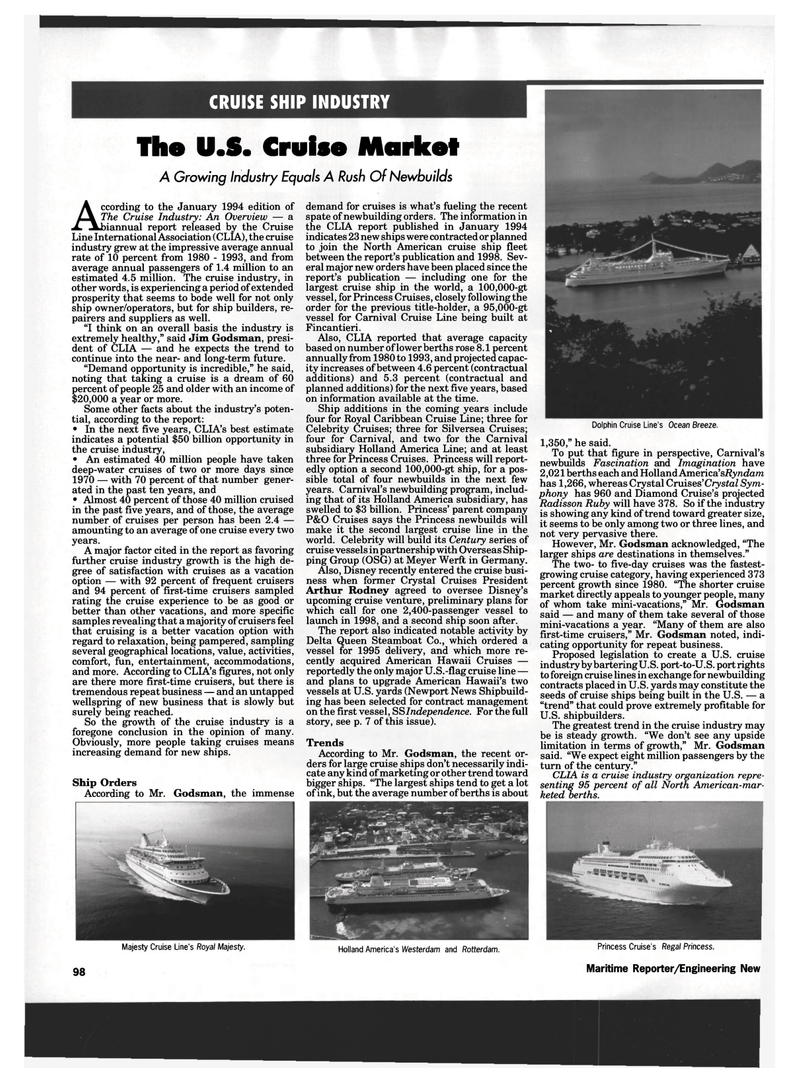
Page 88: of Maritime Reporter Magazine (June 1994)
Read this page in Pdf, Flash or Html5 edition of June 1994 Maritime Reporter Magazine
CRUISE SHIP INDUSTRY
The U.S. Cruise Market
A Growing Industry Equals A Rush Of Newbuilds
According to the January 1994 edition of The Cruise Industry: An Overview — a biannual report released by the Cruise
Line International Association (CLIA), the cruise industry grew at the impressive average annual rate of 10 percent from 1980 - 1993, and from average annual passengers of 1.4 million to an estimated 4.5 million. The cruise industry, in other words, is experiencing a period of extended prosperity that seems to bode well for not only ship owner/operators, but for ship builders, re- pairers and suppliers as well. "I think on an overall basis the industry is extremely healthy," said Jim Godsman, presi- dent of CLIA — and he expects the trend to continue into the near- and long-term future. "Demand opportunity is incredible," he said, noting that taking a cruise is a dream of 60 percent of people 25 and older with an income of $20,000 a year or more.
Some other facts about the industry's poten- tial, according to the report: • In the next five years, CLIA's best estimate indicates a potential $50 billion opportunity in the cruise industry, • An estimated 40 million people have taken deep-water cruises of two or more days since 1970 — with 70 percent of that number gener- ated in the past ten years, and • Almost 40 percent of those 40 million cruised in the past five years, and of those, the average number of cruises per person has been 2.4 — amounting to an average of one cruise every two years.
A major factor cited in the report as favoring further cruise industry growth is the high de- gree of satisfaction with cruises as a vacation option — with 92 percent of frequent cruisers and 94 percent of first-time cruisers sampled rating the cruise experience to be as good or better than other vacations, and more specific samples revealing that a majority of cruisers feel that cruising is a better vacation option with regard to relaxation, being pampered, sampling several geographical locations, value, activities, comfort, fun, entertainment, accommodations, and more. According to CLIA's figures, not only are there more first-time cruisers, but there is tremendous repeat business — and an untapped wellspring of new business that is slowly but surely being reached.
So the growth of the cruise industry is a foregone conclusion in the opinion of many.
Obviously, more people taking cruises means increasing demand for new ships.
Ship Orders
According to Mr. Godsman, the immense
Majesty Cruise Line's Royal Majesty. 98 demand for cruises is what's fueling the recent spate of newbuilding orders. The information in the CLIA report published in January 1994 indicates 23 new ships were contracted or planned to join the North American cruise ship fleet between the report's publication and 1998. Sev- eral major new orders have been placed since the report's publication — including one for the largest cruise ship in the world, a 100,000-gt vessel, for Princess Cruises, closely following the order for the previous title-holder, a 95,000-gt vessel for Carnival Cruise Line being built at
Fincantieri.
Also, CLIA reported that average capacity based on number of lower berths rose 8.1 percent annually from 1980 to 1993, and projected capac- ity increases of between 4.6 percent (contractual additions) and 5.3 percent (contractual and planned additions) for the next five years, based on information available at the time.
Ship additions in the coming years include four for Royal Caribbean Cruise Line; three for
Celebrity Cruises; three for Silversea Cruises; four for Carnival, and two for the Carnival subsidiary Holland America Line; and at least three for Princess Cruises. Princess will report- edly option a second 100,000-gt ship, for a pos- sible total of four newbuilds in the next few years. Carnival's newbuilding program, includ- ing that of its Holland America subsidiary, has swelled to $3 billion. Princess' parent company
P&O Cruises says the Princess newbuilds will make it the second largest cruise line in the world. Celebrity will build its Century series of cruise vessels in partnership with Overseas Ship- ping Group (OSG) at Meyer Werft in Germany.
Also, Disney recently entered the cruise busi- ness when former Crystal Cruises President
Arthur Rodney agreed to oversee Disney's upcoming cruise venture, preliminary plans for which call for one 2,400-passenger vessel to launch in 1998, and a second ship soon after.
The report also indicated notable activity by
Delta Queen Steamboat Co., which ordered a vessel for 1995 delivery, and which more re- cently acquired American Hawaii Cruises — reportedly the only major U.S.-flag cruise line — and plans to upgrade American Hawaii's two vessels at U.S. yards (Newport News Shipbuild- ing has been selected for contract management on the first vessel, SSIndependence. For the full story, see p. 7 of this issue).
Trends
According to Mr. Godsman, the recent or- ders for large cruise ships don't necessarily indi- cate any kind of marketing or other trend toward bigger ships. "The largest ships tend to get a lot of ink, but the average number of berths is about
Holland America's Westerdam and Rotterdam. t
Dolphin Cruise Line's Ocean Breeze. 1,350," he said.
To put that figure in perspective, Carnival's newbuilds Fascination and Imagination have 2,021 berths each and Holland America'sRyndam has 1,266, whereas Crystal Cruises 'Crystal Sym- phony has 960 and Diamond Cruise's projected
Radisson Ruby will have 378. So if the industry is showing any kind of trend toward greater size, it seems to be only among two or three lines, and not very pervasive there.
However, Mr. Godsman acknowledged, "The larger ships are destinations in themselves."
The two- to five-day cruises was the fastest- growing cruise category, having experienced 373 percent growth since 1980. "The shorter cruise market directly appeals to younger people, many of whom take mini-vacations," Mr. Godsman said — and many of them take several of those mini-vacations a year. "Many of them are also first-time cruisers," Mr. Godsman noted, indi- cating opportunity for repeat business.
Proposed legislation to create a U.S. cruise industry by barteringU.S. port-to-U.S. port rights to foreign cruise lines in exchange for newbuilding contracts placed in U.S. yards may constitute the seeds of cruise ships being built in the U.S. — a "trend" that could prove extremely profitable for
U.S. shipbuilders.
The greatest trend in the cruise industry may be is steady growth. "We don't see any upside limitation in terms of growth," Mr. Godsman said. "We expect eight million passengers by the turn of the century."
CLIA is a cruise industry organization repre- senting 95 percent of all North American-mar- keted berths.
Princess Cruise's Regal Princess.
Maritime Reporter/Engineering New

 87
87

 89
89
